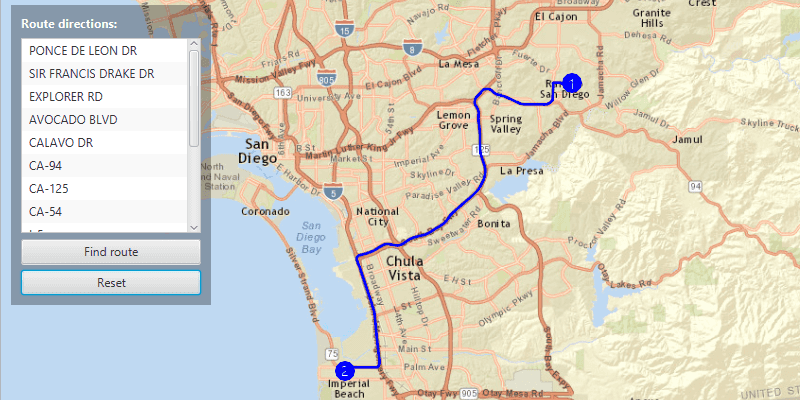Display directions for a route between two points.

Use case
Find routes with driving directions between any number of locations. You might use the ArcGIS platform to create a custom network for routing on a private roads.
How to use the sample
For simplicity, the sample comes loaded with a start and end stop. You can tap on the "Find Route" button to display a route between these stops. Once the route is generated, turn-by-turn directions are shown in a list. You can use the "Reset" button to reset the sample.
How it works
- Create a
RouteTaskusing a URL to an online route service. - Generate default
RouteParametersusingrouteTask.createDefaultParametersAsync(). - Use
setReturnDirectionson the parameters and set to true. - Use
setStopson the parameters to addStops to its stops collection for each destination. - Solve the route using
routeTask.solveAsync(routeParameters)to get aRouteResult. - Iterate through the result's
Routes. To display the route, create a graphic using the geometry fromroute.getRouteGeometry(). To display directions, useroute.getDirectionManeuvers(), and for eachDirectionManeuver, displayDirectionManeuver.getDirectionText().
Relevant API
- DirectionManeuver
- Route
- RouteParameters
- RouteResult
- RouteTask
- Stop
Tags
directions, driving, navigation, network, network analysis, route, routing, shortest path, turn-by-turn
Sample Code
/*
* Copyright 2017 Esri.
*
* Licensed under the Apache License, Version 2.0 (the "License"); you may not
* use this file except in compliance with the License. You may obtain a copy of
* the License at
*
* http://www.apache.org/licenses/LICENSE-2.0
*
* Unless required by applicable law or agreed to in writing, software
* distributed under the License is distributed on an "AS IS" BASIS, WITHOUT
* WARRANTIES OR CONDITIONS OF ANY KIND, either express or implied. See the
* License for the specific language governing permissions and limitations under
* the License.
*/
package com.esri.samples.find_route;
import java.util.ArrayList;
import java.util.List;
import javafx.application.Application;
import javafx.geometry.Insets;
import javafx.geometry.Pos;
import javafx.scene.Scene;
import javafx.scene.control.Alert;
import javafx.scene.control.Button;
import javafx.scene.control.Label;
import javafx.scene.control.ListView;
import javafx.scene.layout.Background;
import javafx.scene.layout.BackgroundFill;
import javafx.scene.layout.CornerRadii;
import javafx.scene.layout.StackPane;
import javafx.scene.layout.VBox;
import javafx.scene.paint.Paint;
import javafx.stage.Stage;
import com.esri.arcgisruntime.ArcGISRuntimeEnvironment;
import com.esri.arcgisruntime.geometry.Envelope;
import com.esri.arcgisruntime.geometry.Geometry;
import com.esri.arcgisruntime.geometry.Point;
import com.esri.arcgisruntime.geometry.SpatialReference;
import com.esri.arcgisruntime.loadable.LoadStatus;
import com.esri.arcgisruntime.mapping.ArcGISMap;
import com.esri.arcgisruntime.mapping.BasemapStyle;
import com.esri.arcgisruntime.mapping.view.Graphic;
import com.esri.arcgisruntime.mapping.view.GraphicsOverlay;
import com.esri.arcgisruntime.mapping.view.MapView;
import com.esri.arcgisruntime.symbology.SimpleLineSymbol;
import com.esri.arcgisruntime.symbology.SimpleMarkerSymbol;
import com.esri.arcgisruntime.symbology.SimpleMarkerSymbol.Style;
import com.esri.arcgisruntime.symbology.TextSymbol;
import com.esri.arcgisruntime.symbology.TextSymbol.HorizontalAlignment;
import com.esri.arcgisruntime.symbology.TextSymbol.VerticalAlignment;
import com.esri.arcgisruntime.tasks.networkanalysis.DirectionManeuver;
import com.esri.arcgisruntime.tasks.networkanalysis.Route;
import com.esri.arcgisruntime.tasks.networkanalysis.RouteParameters;
import com.esri.arcgisruntime.tasks.networkanalysis.RouteResult;
import com.esri.arcgisruntime.tasks.networkanalysis.RouteTask;
import com.esri.arcgisruntime.tasks.networkanalysis.Stop;
public class FindRouteSample extends Application {
private MapView mapView;
private RouteTask routeTask;
private RouteParameters routeParameters;
private final ListView<String> directionsList = new ListView<>();
private Graphic routeGraphic;
private final GraphicsOverlay routeGraphicsOverlay = new GraphicsOverlay();
private final SpatialReference ESPG_3857 = SpatialReference.create(102100);
private static final int WHITE_COLOR = 0xffffffff;
private static final int BLUE_COLOR = 0xff0000ff;
private static final String ROUTE_TASK_SANDIEGO =
"https://sampleserver6.arcgisonline.com/arcgis/rest/services/NetworkAnalysis/SanDiego/NAServer/Route";
@Override
public void start(Stage stage) {
try {
// create stack pane and application scene
StackPane stackPane = new StackPane();
Scene scene = new Scene(stackPane);
scene.getStylesheets().add(getClass().getResource("/find_route/style.css").toExternalForm());
// set title, size, and add scene to stage
stage.setTitle("Find Route Sample");
stage.setWidth(800);
stage.setHeight(700);
stage.setScene(scene);
stage.show();
// authentication with an API key or named user is required to access basemaps and other location services
String yourAPIKey = System.getProperty("apiKey");
ArcGISRuntimeEnvironment.setApiKey(yourAPIKey);
// create a control panel
VBox controlsVBox = new VBox(6);
controlsVBox.setBackground(new Background(new BackgroundFill(Paint.valueOf("rgba(0,0,0,0.3)"), CornerRadii.EMPTY,
Insets.EMPTY)));
controlsVBox.setPadding(new Insets(10.0));
controlsVBox.setMaxSize(450, 300);
controlsVBox.getStyleClass().add("panel-region");
Label directionsLabel = new Label("Route directions:");
directionsLabel.getStyleClass().add("panel-label");
// create buttons for user interaction
Button findButton = new Button("Find route");
findButton.setMaxWidth(Double.MAX_VALUE);
findButton.setDisable(true);
Button resetButton = new Button("Reset");
resetButton.setMaxWidth(Double.MAX_VALUE);
resetButton.setDisable(true);
// find route
findButton.setOnAction(e -> {
try {
RouteResult result = routeTask.solveRouteAsync(routeParameters).get();
List<Route> routes = result.getRoutes();
if (routes.size() < 1) {
directionsList.getItems().add("No Routes");
}
Route route = routes.get(0);
Geometry shape = route.getRouteGeometry();
routeGraphic = new Graphic(shape, new SimpleLineSymbol(SimpleLineSymbol.Style.SOLID, BLUE_COLOR, 2));
routeGraphicsOverlay.getGraphics().add(routeGraphic);
// get the direction text for each maneuver
for (DirectionManeuver step : route.getDirectionManeuvers()) {
directionsList.getItems().add(step.getDirectionText());
}
resetButton.setDisable(false);
findButton.setDisable(true);
} catch (Exception ex) {
ex.printStackTrace();
}
});
// clear the route and the directions maneuver found
resetButton.setOnAction(e -> {
routeGraphicsOverlay.getGraphics().remove(routeGraphic);
directionsList.getItems().clear();
resetButton.setDisable(true);
findButton.setDisable(false);
});
// add buttons and direction list and label to the control panel
controlsVBox.getChildren().addAll(directionsLabel, directionsList, findButton, resetButton);
// create a map with the streets basemap style
ArcGISMap map = new ArcGISMap(BasemapStyle.ARCGIS_STREETS);
// create a map view and set the map to it
mapView = new MapView();
mapView.setMap(map);
// set the viewpoint to San Diego (U.S.)
mapView.setViewpointGeometryAsync(new Envelope(-13067866, 3843014, -13004499, 3871296, ESPG_3857));
// add the graphic overlay to the map view
mapView.getGraphicsOverlays().add(routeGraphicsOverlay);
try {
// create route task from San Diego service
routeTask = new RouteTask(ROUTE_TASK_SANDIEGO);
// load route task
routeTask.loadAsync();
routeTask.addDoneLoadingListener(() -> {
if (routeTask.getLoadStatus() == LoadStatus.LOADED) {
try {
// enable the find route button
findButton.setDisable(false);
// get default route parameters
routeParameters = routeTask.createDefaultParametersAsync().get();
routeParameters.setOutputSpatialReference(ESPG_3857);
// set flags to return stops and directions
routeParameters.setReturnStops(true);
routeParameters.setReturnDirections(true);
// set stop locations
Point stop1Loc = new Point(-1.3018598562659847E7, 3863191.8817135547, ESPG_3857);
Point stop2Loc = new Point(-1.3036911787723785E7, 3839935.706521739, ESPG_3857);
// add route stops
List<Stop> routeStops = new ArrayList<>();
routeStops.add(new Stop(stop1Loc));
routeStops.add(new Stop(stop2Loc));
routeParameters.setStops(routeStops);
// add route stops to the stops overlay
SimpleMarkerSymbol stopMarker = new SimpleMarkerSymbol(Style.CIRCLE, BLUE_COLOR, 14);
routeGraphicsOverlay.getGraphics().add(new Graphic(stop1Loc, stopMarker));
routeGraphicsOverlay.getGraphics().add(new Graphic(stop2Loc, stopMarker));
// add order text symbols to the stops
TextSymbol stop1Text = new TextSymbol(10, "1", WHITE_COLOR, HorizontalAlignment.CENTER,
VerticalAlignment.MIDDLE);
TextSymbol stop2Text = new TextSymbol(10, "2", WHITE_COLOR, HorizontalAlignment.CENTER,
VerticalAlignment.MIDDLE);
routeGraphicsOverlay.getGraphics().add(new Graphic(stop1Loc, stop1Text));
routeGraphicsOverlay.getGraphics().add(new Graphic(stop2Loc, stop2Text));
} catch (Exception ex) {
ex.printStackTrace();
}
} else {
Alert alert = new Alert(Alert.AlertType.ERROR, "Route Task Failed to Load!");
alert.show();
}
});
} catch (Exception e) {
e.printStackTrace();
}
// add the map view and control panel to stack pane
stackPane.getChildren().addAll(mapView, controlsVBox);
StackPane.setAlignment(controlsVBox, Pos.TOP_LEFT);
StackPane.setMargin(controlsVBox, new Insets(10, 0, 0, 10));
} catch (Exception e) {
// on any error, display the stack trace.
e.printStackTrace();
}
}
/**
* Stops and releases all resources used in application.
*/
@Override
public void stop() {
if (mapView != null) {
mapView.dispose();
}
}
/**
* Opens and runs application.
*
* @param args arguments passed to this application
*/
public static void main(String[] args) {
Application.launch(args);
}
}